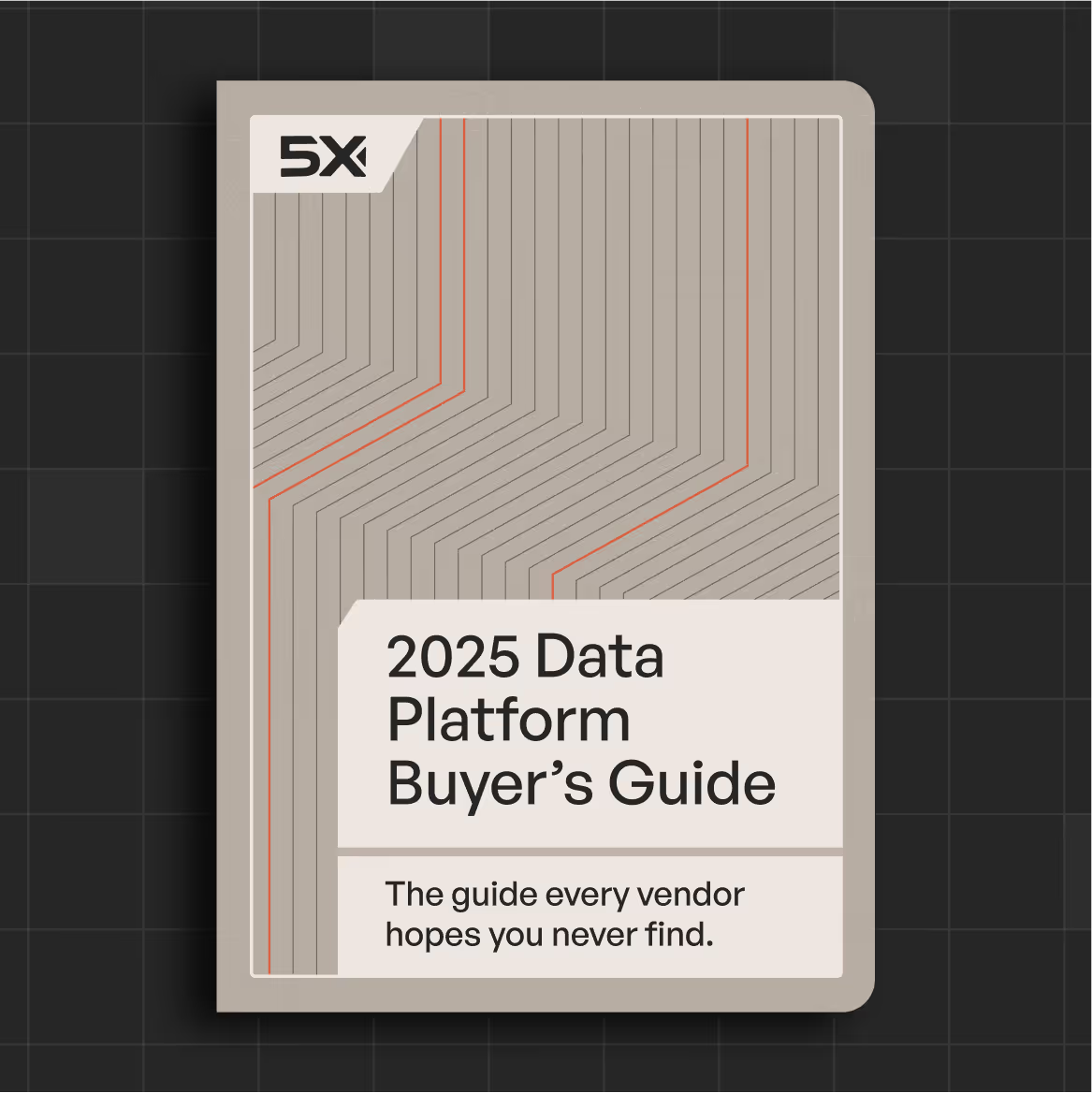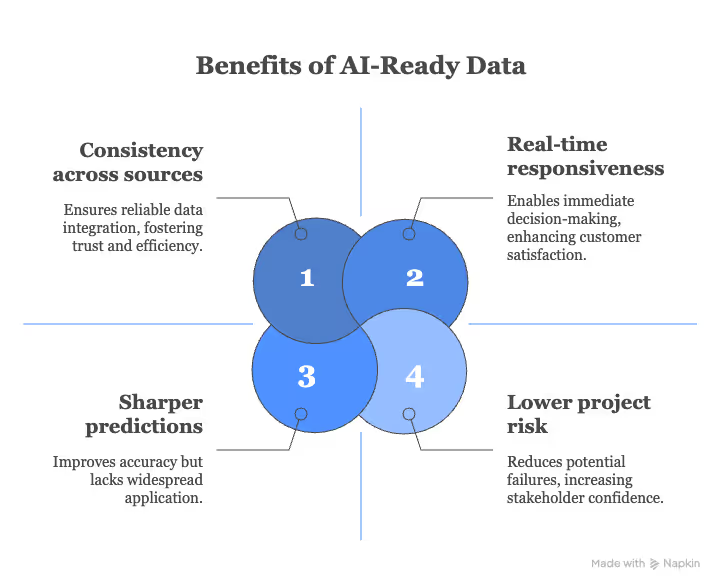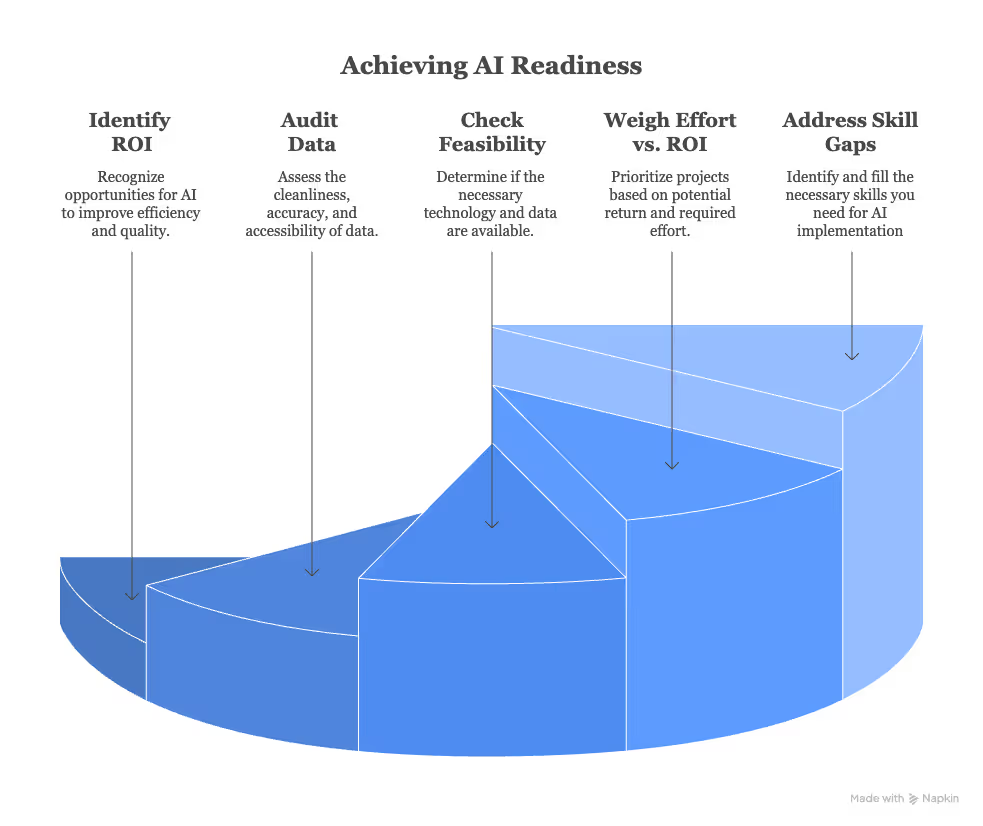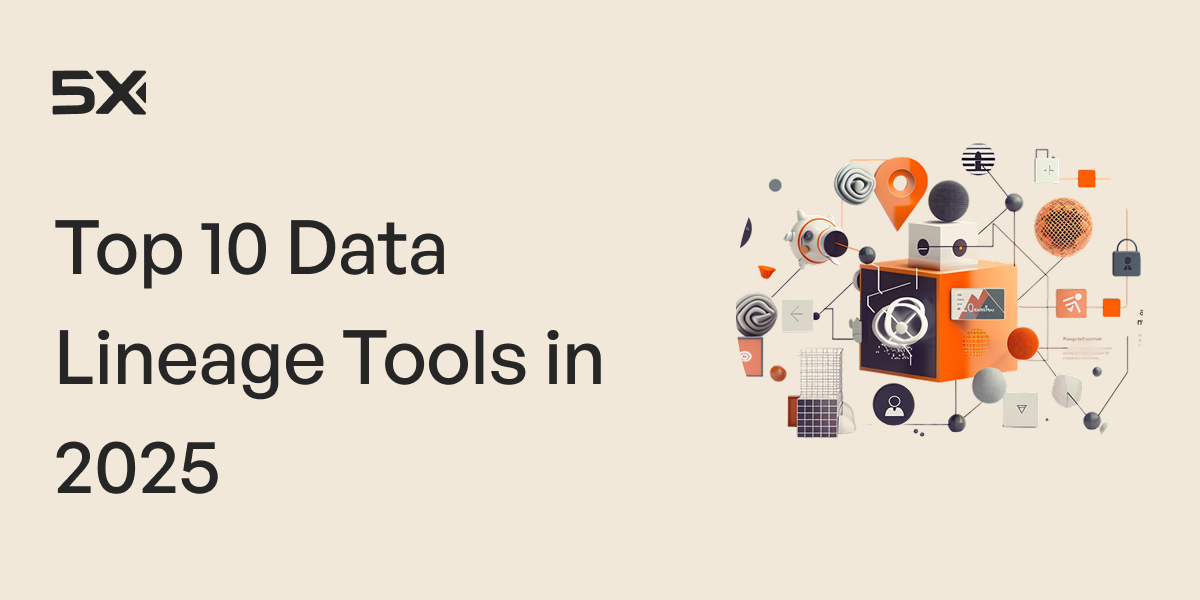How to evaluate your data AI readiness in 5 easy steps

.avif)
.avif)
Table of Contents
TL; DR
- Almost 50% of AI projects fail because the data isn’t AI-ready
- AI-ready data is clean, consistent, integrated, governed, and accessible in real time
- Common roadblocks: data silos, poor quality, compliance gaps, bottlenecks, and bias
- Spot ROI opportunities, audit infrastructure, check feasibility, weigh ROI vs. effort, and close skill gaps to determine your company’s AI readiness
- Treat AI readiness as an ongoing muscle, not a one-time checklist
Your board wanted ROI from AI months ago. And your team is stuck cleaning spreadsheets and chasing missing records. Sound familiar? You’re not alone.
AI is only as good as the data behind it. That’s why almost half of enterprise AI projects stall or fail. Companies pour millions into AI, yet poor-quality, siloed, or poorly governed data leaves teams patching pipelines instead of building game-changing AI use cases that build value.
If you’re frustrated with wasted investments, read this blog to understand where you stand in your AI readiness journey and what you can do to become AI ready.
What is data readiness for AI?
Data readiness for AI means ensuring your data is in a state where it can be trusted, scaled, and fed into GenAI or ML models without constant firefighting. Without this readiness, AI becomes risky and leads to biased hiring tools, mispriced financial products, compliance slip-ups, or brand-damaging mistakes like Google’s Gemini generating historically inaccurate images.
AI data readiness is about centralizing data and creating a system where data is:
- Structured with context: So your AI knows whether “Apple” means a fruit, a tech company, or your biggest enterprise customer
- Clean and consistent: This means that your database must have no duplicates, missing values, or outdated records that turn AI outputs into nonsense
- Integrated across systems: From CRM to supply chain to marketing logs, so AI isn’t stuck with a partial picture
- Governed and compliant: With clear rules on who owns what, how it’s used, and safeguards against bias, leaks, or misuse
- Accessible in real-time: So teams aren’t waiting on batch jobs when they need insights in the moment
Companies that get it right future-proof their data by investing in metadata, lineage, and flexible platforms that can plug into new AI use cases easily. They treat readiness as an ongoing muscle, not a one-time checklist. In short, data readiness is the bridge between AI hype and AI value.
Common examples of using AI when you’re not ready
Studies show that nearly 50% of enterprise AI projects fail due to poor data quality and preparation. Here are some examples of what AI can cost you when data is not fully used:
- Personalization gone wrong: An e-commerce platform recommending maternity products to teenagers because browsing data wasn’t cleaned or contextualized
- Inventory forecasting misses: A retailer predicting stock demand without seasonal data, leading to empty shelves in peak season and excess stock when demand drops
- Healthcare risk scoring: An AI model trained on incomplete patient histories that overlooks pre-existing conditions, resulting in dangerous misdiagnoses
- Fraud detection blind spots: A financial institution using outdated transaction data, causing the AI to flag normal customer behavior as fraud while missing actual threats
- Employee performance tools: HR AI models ranking staff unfairly because training data ignored qualitative feedback, fueling disengagement and attrition
Why do you need AI-ready data for your business?

Getting your data “AI-ready” determines whether AI becomes a competitive advantage or just another hype cycle inside your company. Here’s why you need AI-ready data:
- Sharper predictions and recommendations: Clean, accurate, and consistent data lets AI find patterns you’d never spot on your own. Think of a retailer using structured purchase data to drive personalized recommendations that boost cart size by 20%. Without that foundation, the same system might suggest winter jackets to someone shopping in June
- Consistency across every source: AI is only as good as the context it sees. If your CRM shows one customer address, your ERP shows another, and your IoT sensors contradict them both, your AI is working with noise, not truth. Harmonized, AI-ready data solves this and gives you a single reliable view across systems
- Real-time responsiveness: AI-ready pipelines mean you’re not waiting on batch updates. For example, a supply chain platform can use live IoT data to reroute shipments the moment it detects a delay. That kind of responsiveness turns disruption into advantage and makes life easier for your customers, thereby helping build brand love
- Lower project risk, higher adoption: Every failed AI project isn’t just a sunk cost. It’s lost trust. Executives pull back funding, teams get skeptical, and momentum dies. By preparing data upfront with governance, security, and validation, you reduce the risk of biased or unreliable outputs. When teams see models working reliably from day one, adoption goes up
AI without AI-ready data is like racing a Formula 1 car on a dirt road. You’ll spin your wheels, burn resources, and never hit top speed. Companies that invest in strong, consistent, governed data pipelines aren’t just playing with AI. They’re winning with it.
Challenges in achieving data readiness for AI
Getting your data “AI-ready” sounds simple enough until you try to make it happen. Most companies quickly realize that the problem isn’t building the model, it’s building the data foundation that model can actually trust. Here’s where things usually go wrong:
- Data stuck in silos: Your marketing team has one dataset, finance has another, and your operations team is buried in spreadsheets. No one talks to each other. That’s a problem because AI works best when it sees the full picture which isn’t the reality in most cases
- Messy data quality: Duplicates, missing fields, and outdated records are all more common than anyone likes to admit. Moreover, garbage data going into an AI model means garbage insights coming out, often amplified at scale. Sadly this is true for most organizations, even those that consider themselves as “data-driven”
- Security and compliance risks: We’ve already seen businesses hit with multi-million dollar fines for sloppy governance. Between GDPR, CCPA, HIPAA, and now AI-specific rules coming into play, the cost of missteps isn’t small. Ensuring strong compliance frameworks, transparent data use policies, and regular audits is a must, but unfortunately, most organizations do not follow compliance norms
- Accessibility bottlenecks: Sometimes the issue isn’t too much access, but too little. Legacy systems, outdated infrastructure, and long approval cycles keep data scientists waiting weeks for datasets they need today. If this sounds like you, your projects may stall and it may take too much time to make your data ready for artificial intelligence
- Bias and ethical concerns: Data is never neutral. If your historical hiring data prefers male candidates, your recruitment AI will too. If your product returns a dataset that underrepresents certain regions, your demand forecasts will miss them. This isn’t just a fairness issue, but a business risk as well. Biased models alienate customers, invite lawsuits, and damage trust. Oftentimes, organizations collect and actively build data that’s biased, making your organization ill-equipped for AI innovation
At the end of the day, the biggest challenge isn’t just technical, it’s cultural. Teams need to stop treating data as a departmental asset and start treating it as an enterprise resource. Until that shift happens, AI readiness will remain more buzzword than reality.
Step-by-step AI readiness assessment

The first step towards data readiness is figuring out if you’re even ready. Here’s a five-step practical framework you can follow to check your organization’s AI readiness.
Step 1: Spot ROI opportunities
Don’t start with “what’s the coolest AI use case?”, instead, start with “where’s the pain?”
Look at where your teams are buried in repetitive work such as manual data entry, endless reporting, customer support tickets, or even onboarding new users. These are prime candidates for AI.
Now go one step further and identify where AI could save you time and improve quality. This means fewer errors in reports, consistent customer experiences, and stronger quality checks. Write down these opportunities and rank them by business impact. That’s your starting list.
Step 2: Audit your data infrastructure
AI is hungry. It runs on data. But is your data ready?
Start by mapping the basics such as where it's coming from (CRM, sensors, spreadsheets, cloud apps) and assess if it is clean, accurate, and accessible, or is it stuck in silos.
If you can, sketch your data architecture. Highlight what’s working, what’s broken, and where you need to fix processes. Without this, your AI project won’t get off the ground.
Step 3: Check feasibility
Not every idea is worth chasing, at least not today. Some projects that looked impossible last year are suddenly doable now. Others still need time. Do two quick checks:
- Tech check: Does the tech already exist (commercially or open source) or will you be inventing something brand new?
- Data check: Do you actually have the right data to train the model? If the answer is “not yet,” park it. Focus where feasibility is high. For example, a churn prediction engine is useless without years of customer history
Step 4: Weigh effort vs. ROI
Here’s where strategy comes in. Plot your use cases on a grid that maps your ROI vs. Effort.
- High ROI + Low Effort = Quick wins. Start here
- High ROI + High Effort = Worthwhile, but maybe not first
- Low ROI = Don’t waste your time
Example: Automating email categorization could be a quick win. Building a custom language model for niche tasks? That might sit on the backlog for now.
Step 5: Mind the skill gaps
Even the best plan fails without people who can run it. Do a skills test to understand who on your team knows data science, ML, or AI ethics and where the gaps are.
Then decide if you should train, hire new employees, or partner. Upskill existing teams with workshops and certifications. Hire AI engineers if needed. Or bring in consultants and staff augmentation partners until you’re ready to scale in-house.
How 5X accelerates AI readiness
Most companies fail at AI because the data foundation is too messy. Silos, patchwork pipelines, endless governance gaps stunts your AI readiness.
5X solves this. Instead of wasting months stitching tools together, 5X gives you an out-of-the-box data foundation that’s built for AI from day one. Think scalable pipelines, rock-solid governance, real-time accessibility, and integrations that don’t break when you add a new system.
- Struggling with siloed data? 5X unifies it so AI sees the full picture
- Fighting poor data quality? 5X bakes in validation and governance upfront
- Stuck with slow infrastructure? 5X pipelines are designed for real-time AI workloads
By plugging into 5X, you skip the painful setup phase and go straight to experimenting, building, and scaling AI use cases that actually stick.
FAQs
How do you evaluate AI readiness?

What is the data readiness assessment for AI?

What are the stages of AI readiness?

Why do so many AI projects fail?

How can I quickly improve my AI readiness?

Building a data platform doesn’t have to be hectic. Spending over four months and 20% dev time just to set up your data platform is ridiculous. Make 5X your data partner with faster setups, lower upfront costs, and 0% dev time. Let your data engineering team focus on actioning insights, not building infrastructure ;)
Book a free consultationHere are some next steps you can take:
- Want to see it in action? Request a free demo.
- Want more guidance on using Preset via 5X? Explore our Help Docs.
- Ready to consolidate your data pipeline? Chat with us now.
Get notified when a new article is released
Unify data for AI with 5X
Unify data for AI with 5X

How retail leaders unlock hidden profits and 10% margins
Retailers are sitting on untapped profit opportunities—through pricing, inventory, and procurement. Find out how to uncover these hidden gains in our free webinar.
Save your spot






%201.svg)
.png)








